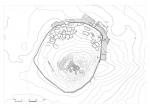Summary (English)
The 2017 campaign was dedicated to three activities: 1) continuation of the topographical survey of the settlement; 2) restoration work on the tannery (room K2) and the sacred area of the fortress (rooms γ2 e β2); 3) documentation, study and publication of the excavation data.
The topographical survey, begun in 2016, was completed in 2017 and also involved digitizing the earlier documentation (based on surveys undertaken in previous years by Ati Ifras), and digitization of the excavation data from the areas investigated to date.
The processed topographical data was used to create a general map of the settlement, which takes into account fundamental functional elements, such as the complete circuit of the Iron Age I walls, and the Iron Age II extension of the fortifications in the north and north-eastern quadrants (fig. 1). In addition, a general plan of the areas of the fortified site excavated to date, indicating the “quarters” and individual rooms, has been extrapolated from the topographical map.The second line of activity was dedicated to the restoration/conservation of the site and included a series of interventions on exposed surfaces in the most important areas excavated to date, in particular the beaten clay floors to which biocide was applied.
The third activity involved the graphic documentation and study of the occupation contexts investigated thus far, while the publication regarded the latter (with the complete publication of the diagnostic pottery) and all areas excavated to date. The pottery production was studied not only from the morphological-typological point of view but also looked at technological and archaeometrics, through the proposal of a new method of classification for pottery production in the settlement during the local Iron Age II.
- Carla Perra - Museo Archeologico Villa Sulcis, Comune di Carbonia
Director
Team
- Roberto Sirigu
- Rita Ciardi - Ditta L’OFFICINA CONSORZIO, Roma
- Valentina Notari - Ditta L’OFFICINA CONSORZIO, Roma
- Maristella Cera - ex Società ATI IFRAS s.c. a r.l.
- Maria Antonietta Demurtas
Research Body
- Museo Archeologico Villa Sulcis
Funding Body
- Comune di Carbonia
- Istituto ISMA- CNR






![Download [PDF]](/excavation/skins/fasti/images/results/download_sml.png)